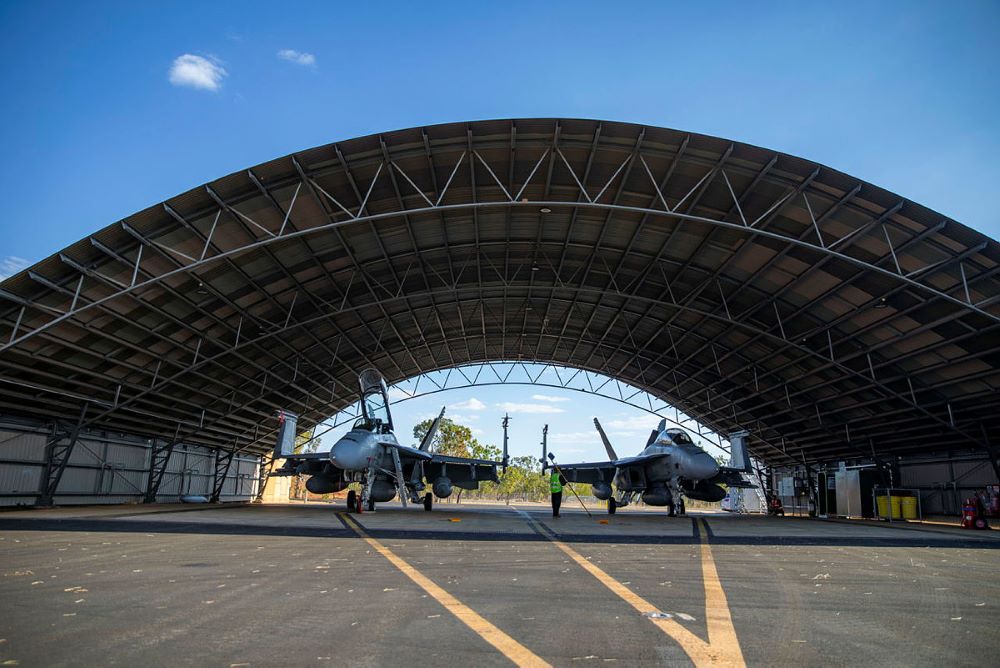
Last year, while standing on the foreshore at Nightcliff in Darwin at low tide, I watched an ascending Bell MV-22 Osprey transforming from helicopter to airplane mode.
Looking down just after it passed, I saw a piece of corroded aluminium protruding from the mud. It turned out to be wreckage from a hostile Mitsubishi A6M fighter destroyed by Darwin’s air-defence systems in 1942 or 1943.
Darwin has been a strategic military base since 1911, when the navy established a ‘naval reserve subdistrict’ in Darwin staffed by one lieutenant, a chief petty officer and a boatman.
By 1932 the ‘Darwin Detachment’ comprising five officers and 42 men became the first Australian unit to be permanently stationed in Darwin. ‘The Garrison did not change Darwin’s ways. It became part of them,’ historian Alan Powel writes in The shadow’s edge: Australia’s northern war.
As part of Britain’s ‘Singapore strategy’, Darwin became the site for a strategic reserve of bunker fuel for allied naval forces. The first four storage tanks were built between 1924 and 1928, adjacent to the civilian wharf and close to the city’s administrative centre.
When plans for the oil tanks in Darwin were being finalised, their susceptibility to attack by enemy aircraft was inconceivable.
On 9 February 1942, the Japanese First and Second Carrier Divisions under Vice Admiral Chuicki Nagumo, fresh from Pearl Harbor, attacked and destroyed the oil tanks, allied shipping and other military and civilian infrastructure around Darwin Harbour. Fifteen civilians were killed in the first raid.
The perceived threat of imminent invasion prompted a massive build-up of defence forces and infrastructure. The construction of army camps close to the town permanently shaped the development of Darwin as a post-war city. After demobilisation, the abandoned military camps were occupied by civilians. These camps became the foundation for Darwin’s suburbs of Stuart Park, Parap, Nightcliff and Winnellie. By 1952, Darwin’s civilian population was 8,214, an increase of 240% from 1947.
Of the thousands of service personnel posted to bases in the Northern Territory during World War II, ‘the majority did not like it’. The negative impression of both the area and the capability of the local population became an indelible part of Australian Defence Force culture, and NT bases are still considered by many to be ‘hardship postings’.
Earlier this year in Darwin, the Minister for Defence Industry, Pat Conroy stated: ‘We are facing the biggest arms race in our region since 1945.’
The 2023 defence strategic review identifies the imperative to ‘comprehensively remediate’ northern bases including Royal Australian Air Force Base Darwin and RAAF Base Tindal near Katherine. Both the current and previous Australian governments have talked about investing $8 billion to do so. The scope of those projects touches every conceivable defence activity.
A topical example is the $200-plus million to expand Tindal’s capacity to accommodate Northrop Grumman’s MQ-4C Triton unmanned surveillance aircraft. Much of the work on base is going to NT-based businesses, but it’s notable that the ADF has left the company, and others, to work out how to house their employees who will maintain the Tritons.
Katherine is a small community and it makes no sense to operate so independently, when success genuinely relies on collaboration.
NT government officials attempting to obtain a coherent picture from ADF colleagues about the scope of the proposed defence build-up have been met with limited information. Collaboration is essential if we are to ensure that we don’t repeat past mistakes based on unrealistic expectations about the capacity of infrastructure and local housing and labour markets to meet anticipated demand.
There are several critical issues that should be forefront in the strategic thinking of ADF officers charged with delivering the objectives of the defence strategic review in the NT.
First, in no other capital city in Australia are the citizens more conscious of the reality and implications of the military presence, exemplified by the response to the deaths of the three US marines when their MV-22B Osprey crashed and caught fire at Melville Island: it was ‘a loss felt across the entire community’.
Second, so much of what the ADF does in the Top End is dependent on shared civilian infrastructure. This includes the hospitals, airport, the wharf and associated fuel stores and of course, roads.
Finally, planning decisions cast long shadows. When decisions are made remotely without engagement with the local situation, opportunities are lost—which in turn generates negative risks.
In common with the ADF, the NT Planning Commission works on strategic planning horizons and would welcome a collaborative approach. Ultimately, we are all in this together, and to succeed we must work together.

